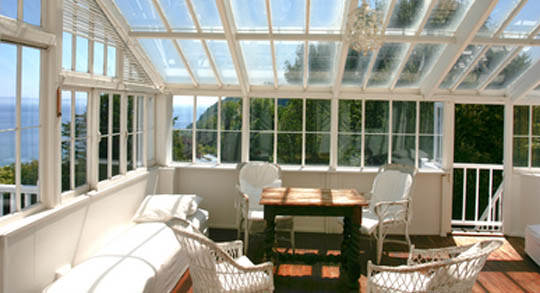



Passive solar house plans vary by building location and climate, but the basic approaches stay the same -- maximize solar energy heat gain in winter and minimize it in summer. The design doesn’t have to be intricate, but it requires an understanding of solar geometry, new window technology, and local weather patterns. With an appropriate building site, pretty much any type of architecture can integrate passive solar design.
1.) Cutting losses. A passive solar home should start out well insulated and sealed. An energy efficient home reduces heat loss and gain making passive solar techniques that much more effective.
2.) Site Orientation. The building’s southern exposure must be open to sunlight and clear of large obstacles (tall buildings, tall trees). A true southern exposure is the best way to exploit passive solar power; it is not mandatory and sometimes not even possible. Provided the building faces with 30 degrees of due south, south-facing windows will receive about 90 percent of the best possible winter solar heat gain.
3.) Window selection. It is easy to receive passive solar energy through a window -- just let the sun shine in. Glass’s natural properties let sunlight though but trap long-wave heat radiation, keeping the house warm (the greenhouse effect). The challenge is to properly size the south-facing windows to balance heat gain and heat loss without overheating. New window technologies, including selective coatings, increase window insulation properties to help keep heat where it is needed. In heating climates, reduce the window area on north, east and west facing walls, while still letting in enough daylight for a pleasant atmosphere. In cooling climates, make the north-facing windows larger and liberally shade the south-facing windows. Shading from landscaping, shutters, overhangs, and solarized window screens will help reduce heat gain on windows that receive full sun.
4.) Suntempering. In cold climates, suntempering means orienting most of the home’s windows toward the south. It is a simple method, which maximizes passive solar heat gain -- a window area of up to 7 percent of the building floor area can be oriented toward the south. More windows can effectively be added if more thermal mass is built in. This efficient passive solar heating strategy is a low cost option that relies on careful planning.
5.) Shading. Appropriately sized window overhangs or awnings are a great option to maximize southerly solar heat gain and shading. They shade windows from the summer sun and, in winter when the sun is lower in the sky, let light pass through the window to warm the inside of the house. Full-grown deciduous trees allow most winter sunlight to pass through while providing dappled shade during summer.
6.) Heat Storage. Thermal mass, or materials used to store heat, is a fundamental tenet of most passive solar design. Materials such concrete, masonry, wallboard, and even water absorb heat during sunlit days and slowly release it as temperatures drop. This mitigates the effects of outside air temperature changes and moderates indoor temperature.
7.) Natural Cooling. Outdoor air can often cool a home without need for air conditioners. Opening windows at night to flush the house with cooler air and closing windows and shades by day greatly reduces the need for supplemental cooling. Cross-ventilation is an effective way to capture cooling, flow-through breezes. Clerestory windows and solar attic fans let naturally rising warm air out. Fans help lower-level openings bring in cooler, refreshing replacement air.
Passive solar design requires more thorough analysis and attention to detail than typical design. Passive solar features like bigger roof overhangs, additional thermal mass and window glazing can add upfront cost to the project. Fortunately, these expenses are easily recovered over the life of the building in reduced energy and maintenance costs.
Source: Southface Energy Institute Passive Solar Design
Tags: Passive solar, passive solar house plans, passive solar homes, passive solar heating, passive solar water heater, passive solar design, passive solar heat, passive solar home plans, passive solar residential, passive solar energy, passive solar home, passive solar floor plans...
877-331-1235 | © Copyright DASolar.com.